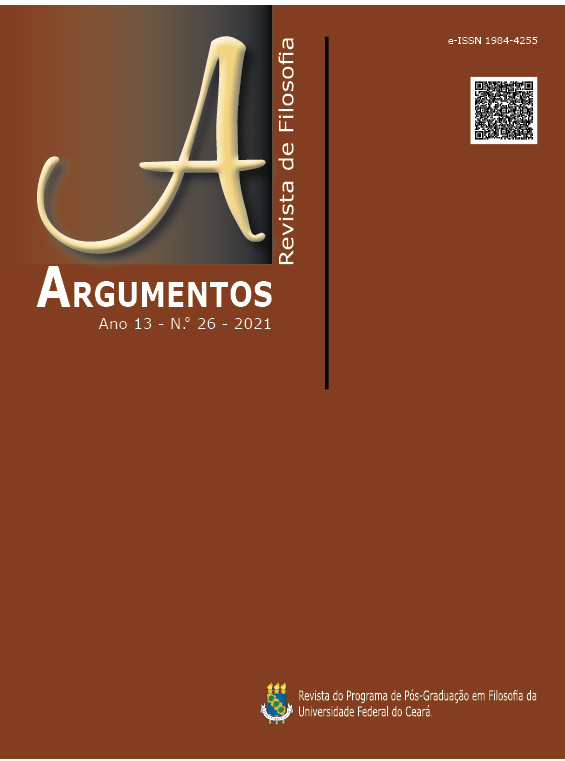Allusions the first part of Thus spoke Zaratustra in Nietzsche’s letters: creation as and educational perspective
DOI:
https://doi.org/10.36517/Argumentos.26.7Keywords:
Education. Art. Suffering. Creation.Abstract
During the years 1881 and 1885, Nietzsche had his first intuitions, wrote and published the work Thus spoke Zarathustra. In the present text, we will focus on the circumstances that bordered this event based on the correspondences that the philosopher wrote to several people in the period. Only the initial moments in which the Zarathustra is portrayed will be addressed, when the German thinker highlights the relationship that is always present in the missives, between thought and nature; it establishes proximity between the act of writing, an activity that he understood as a task, with thought and life. Nietzsche also assessed his personal health problems and, at the same time, that of collective weakness, which required “help to himself”, to face both personal illnesses and those imposed by gregarious life. Art, in its diverse manifestations, but, above all, music figured as educational and curative means, through which he can seek impulse to create, to be a soldier, capable of giving life to a powerful work, such as the Zarathustra. A serious and cheerful book, created within a particular and social environment in which it was necessary to transform “suffering into gold”.
References
ANDRADE, Daniel Pereira. Nietzsche - a experiência de si como transgressão (loucura e normalidade). São Paulo: Annablume, 2007, p. 102.
AZEREDO, Verônica Pacheco de Oliveira. Nietzsche, a grande saúde e o sentido trágico da vida. Cadernos Nietzsche, 28, 2011.
DIAS, Rosa Maria. DIAS, Rosa. Maria. Passagem nietzschiana. Rio de Janeiro, Mauad X, 2019.
______. DIAS, Rosa Maria e OLIVEIRA, Marina Gomes de [et al]. Nietzsche e as cartas. 1 ed. Rio de Janeiro: Via Verita, 2019.
GONZÁLEZ, Mariano Rodríguez. Mantenha-se mediterrâneo!”: Razões do entusiasmo de Nietzsche por Carmen. Cad. Nietzsche vol.38 no.1 São Paulo Jan./Apr. 2017.
JANZ, Paul Curt. Friedrich Nietzsche. 4 vols. Trad. Jacobo Muñoz. Madrid: Alianza, 1987.
MARQUES, Antonio. “No fundo sou todos os homens da história”: Nietzsche: Os vinte anos fundamentais a partir de suas cartas. Círculo de Leitores, 1996.
NIETZSCHE, Friedrich. Além do bem e do mal. Tradução Paulo César de Souza. São Paulo: Companhia das Letras, 1992.
_____. Sämtliche Werke: Kritische Studienausgabe In: 15 Bänden. Edição organizada por G. Colli e M. Montinari. Berlim: Walter de Gruyter, 1999.
______. A gaia ciência. Tradução Paulo César de Souza. São Paulo: Companhia das Letras, 2001.
_______. Ecce homo: como alguém se torna o que é. Trad. Paulo César de Souza. São Paulo: Companhia das Letras, 2008.
______. Assim falou Zaratustra, um livro para todos e para ninguém. Tradução de Mario da Silva. 18ª edição, Rio de Janeiro: Civilização Brasileira, 2010.
______. Correspondencia IV Enero 1880 – Diciembre 1884. Traducción, introducción, notas y apéndices de Marco Parmeggiani. Editorial Trotta, Madrid, 2010.
______. Assim falou Zaratustra: um livro para todos e para ninguém. Tradução, notas e posfácio de Paulo César de Souza, São Paulo: Companhia das Letras, 2011.
______. Correspondencia V Enero 1885 – Octubre 1887. Traducción, introducción, notas y apéndices de Juan Luis Vermal. Editorial Trotta, Madrid, 2011.
_____. Digitale Kritische Gesamtausgabe von Nietzsches Werken und Briefen. Edição organizada por Paolo D'Iorio, baseada na edição crítica de G. Colli e M. Montinari e publicada pela Nietzsche Source. Edição eletrônica. Acesso em 01/04/2020.
SALOMÉ, Lou Andrés. Nietzsche e Lou: In: Correspondências e outros documentos - Introdução, 1ª edição, Via Verita, Rio de Janeiro, 2019.
Downloads
Published
Issue
Section
License
Argumentos magazine is licensed under an International Creative Commons Attribution License.
The Magazine uses CC BY inclusion
1) The authors retain the copyright granted to the magazine or the right to initial publication, with the work regularly licensed under the Creative Commons Attribution, which allows the sharing of the work with acknowledgment of authorship and initial publication in this magazine.
2) The authors are authorized to contract additional applicable contracts, for non-exclusive distribution of the version of the work published in this journal (for example, publication in the institutional repository or as a chapter of the book), recognition of authorship and initial publication in this journal.
3) Authors are authorized and encourage to publish and distribute their work online (for example, in institutional repositories or on their personal pages) at any time before or during the editorial process, as they can generate productive changes, as well as increase the impact and reference of published work.




.jpg)










._._3.png)
1.jpg)
._._._.png)
